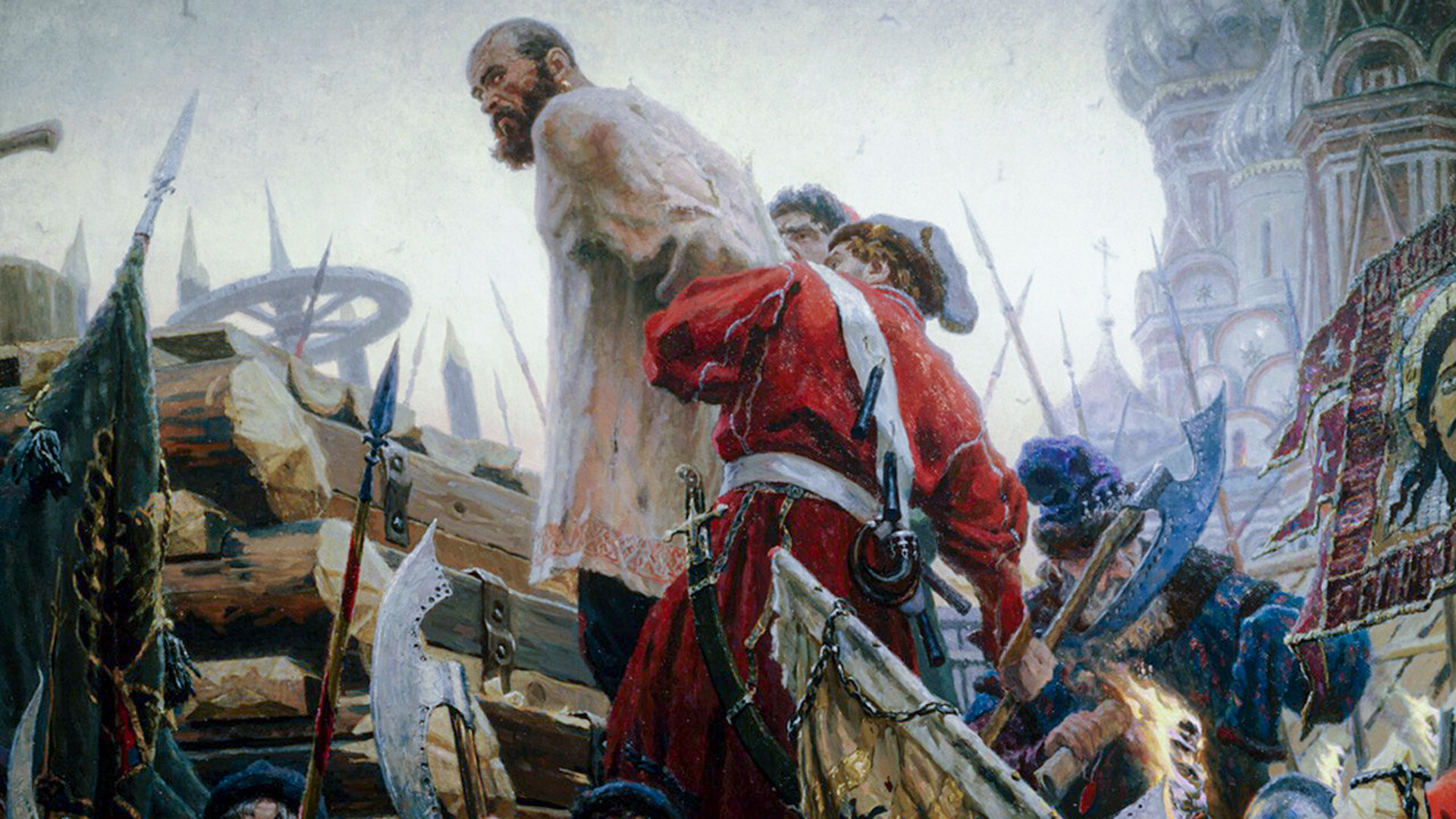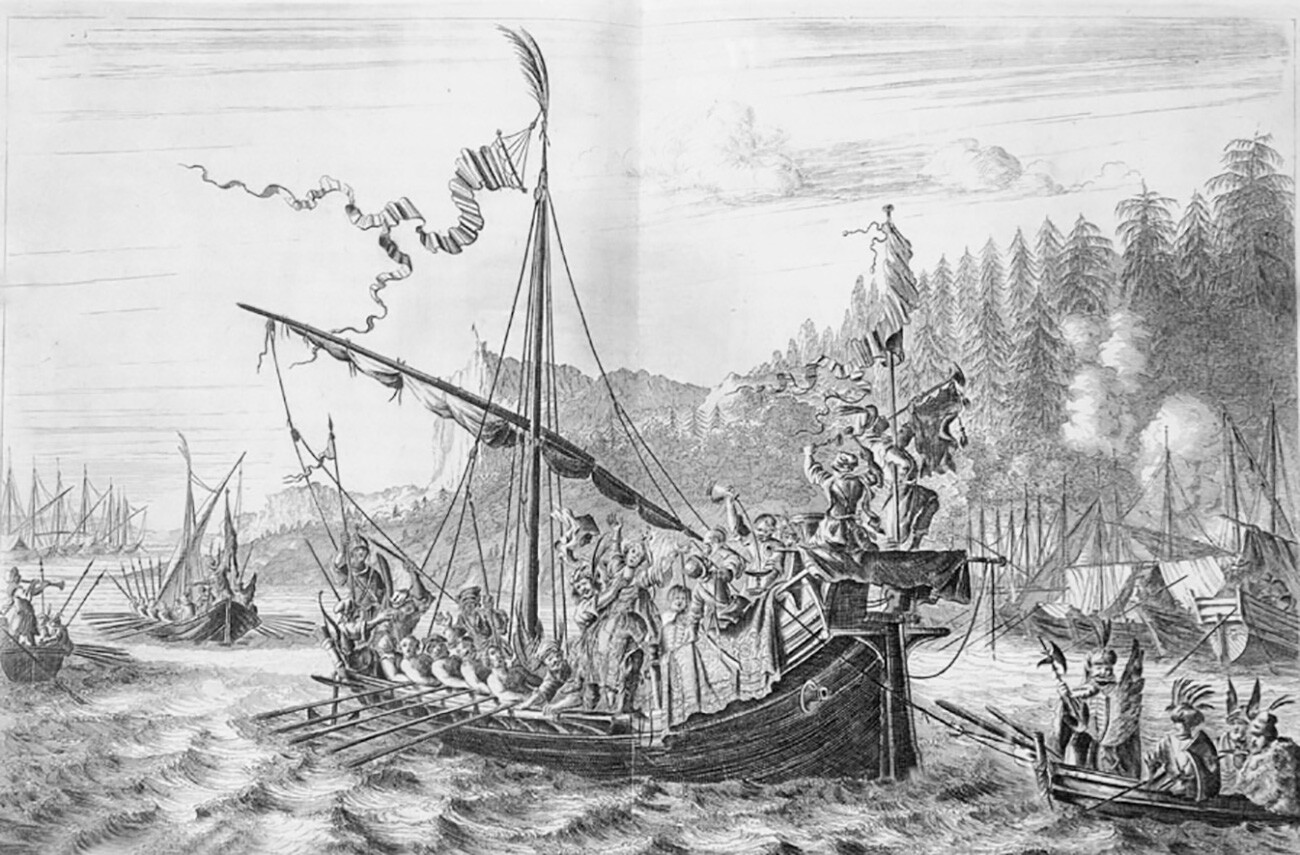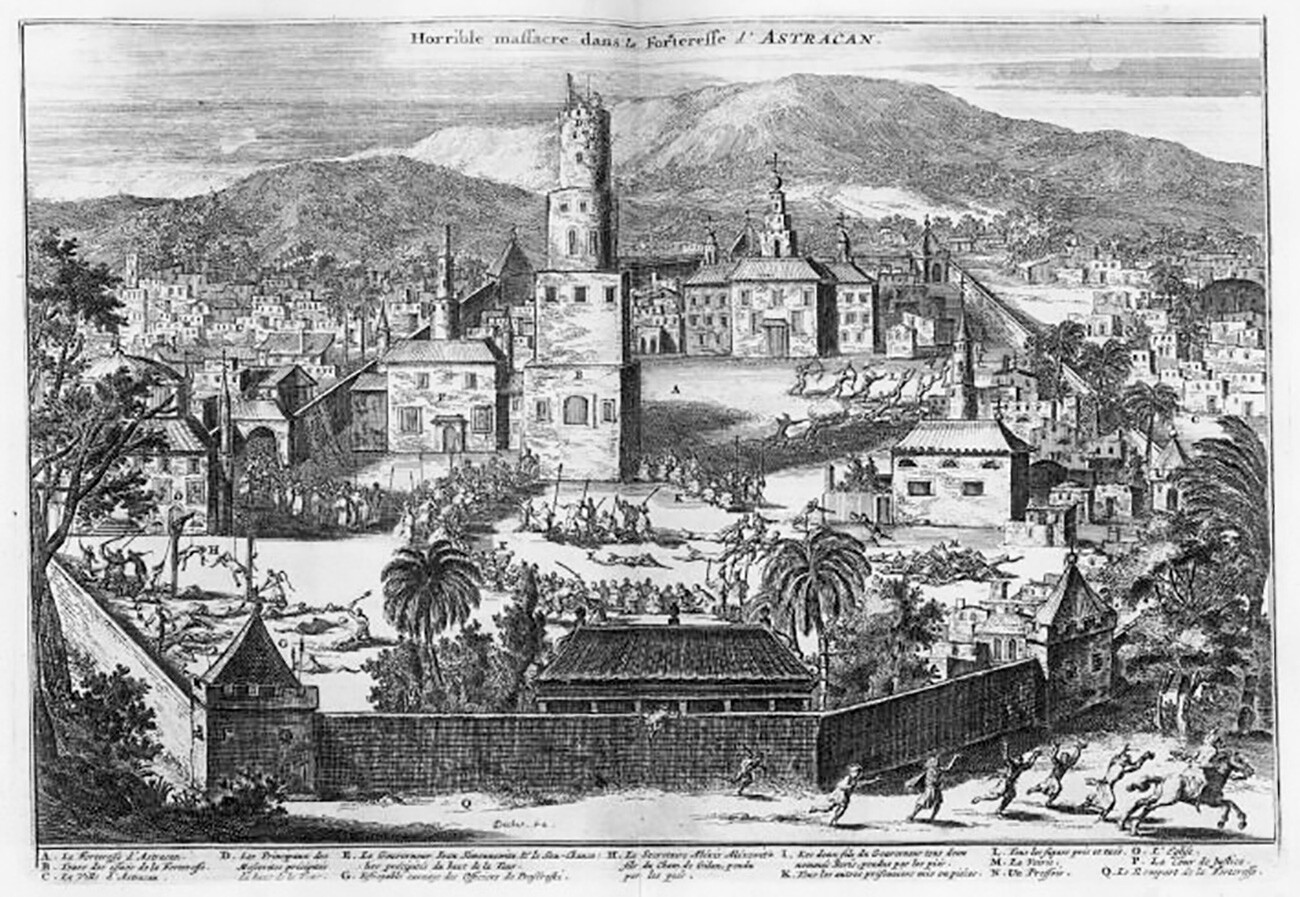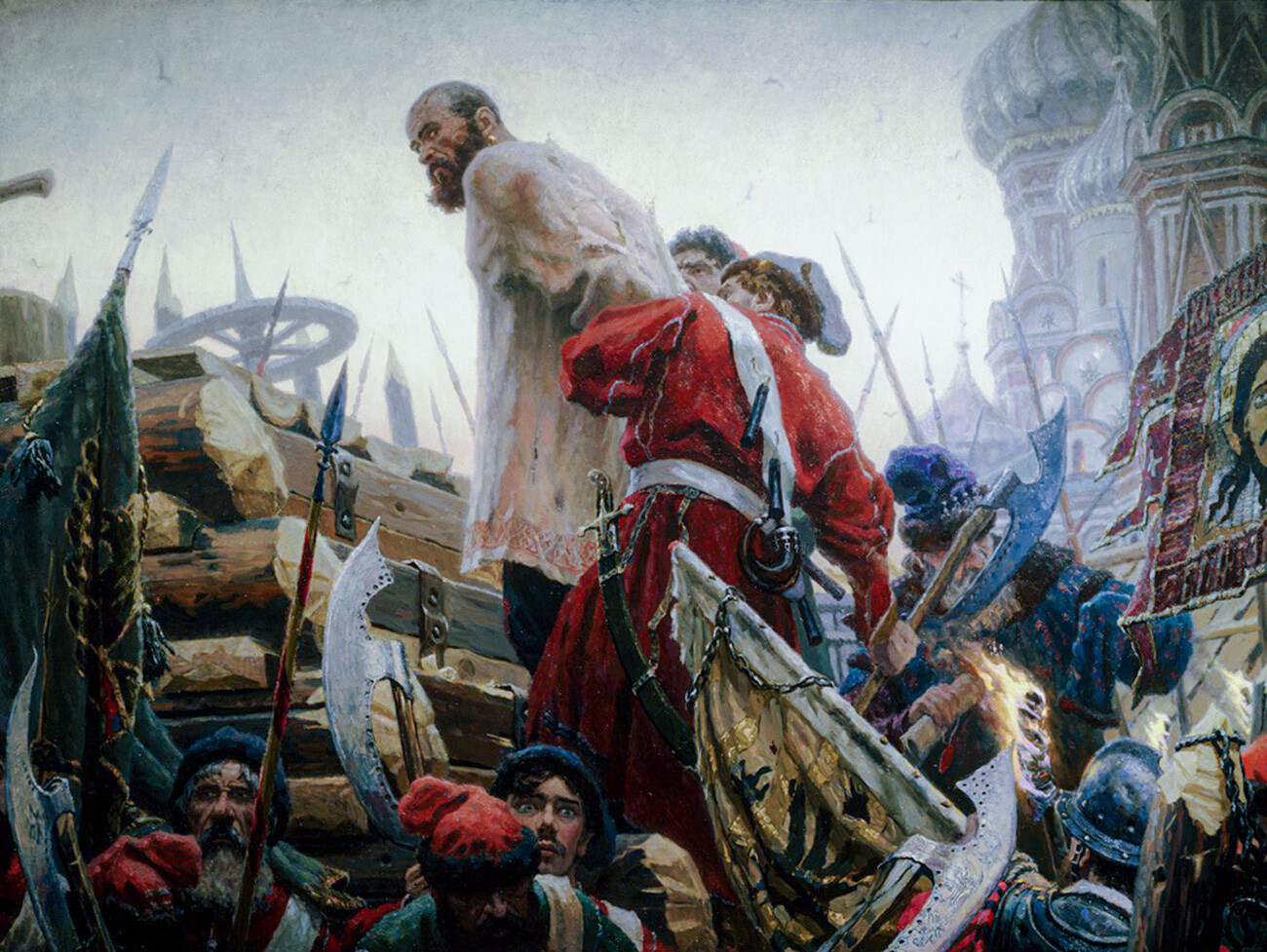
Razin's execution
Sergey Kirillov (CC BY-SA 3.0)In the second half of the 17th century, Russia lived through one of the most brutal and bloody uprisings in its history. Tens of thousands of Cossacks and peasants plunged the south of the country into a state of chaos and horror. They seized and plundered towns and cities, massacred landowners and hanged tsarist officers.
The rebels were led by Don Cossack Stepan (known as Stenka) Razin. For some, he became a national hero and defender of the poor and dispossessed, for others, a traitor, robber and scoundrel.
Razin is believed to have been born in 1630. Thanks to his personal qualities and good luck, by the age of 30 he had managed to become one of the most prominent Cossack atamans.

"His appearance was stately and his posture noble, while the expression on his face was arrogant; he was tall and had a slightly pockmarked face. He had the ability to instill fear and love at the same time. Whatever orders he gave were executed without question and without complaint," is what Dutch traveler Jan Struys, who met the ataman in person, wrote about him.
The tsar's authority on the Don was very weak at the time and the Cossacks enjoyed a certain degree of freedom in their domestic and foreign policy. Nevertheless, Moscow regularly involved the Cossacks in its military campaigns. Stepan Razin participated in them, too, fighting against the Turks and Crimean Tatars.
Stenka's elder brother, Ivan, also fought for the tsar. In 1665, he was in the army of Tsarist Voyevoda Prince Yuri Dolgorukov, which was conducting military actions on the territory of the Polish-Lithuanian Commonwealth.
At some point, Ivan and a group of his fellow comrades decided that their term of service to the tsar was up. They tried to leave the army and return to the Don, but were captured and executed for desertion. Stepan Razin could not forgive the Tsardom of Muscovy for this.

At the same time, personal grievances would not have been sufficient to stir people up against the boyars and tsarist authority. Those who joined Razin had their own bone to pick with Moscow.
The life of the Russian peasantry in the second half of the 17th century was very difficult. Peasants had to contend with exhausting wars against the Swedes and Poles, the most serious plague epidemic for a century and famine caused by failed harvests. On top of everything else, a code of law promulgated in 1649 (the so-called ‘Council Code’) consolidated the servitude of the peasants, effectively making them the chattels of landowners.
In their quest for freedom and a better life, peasants fled to the Don, from where they could have no fear of being sent back. Nevertheless, no land of milk and honey awaited them there either. All the good land had been divided up among the well-to-do or so-called ‘domovitye’ (literally: ‘propertied’ or ‘settled’) Cossacks and the remainder could only join the poor Cossack class known as the ‘golutva’ (derived from the word ‘goly/golaya’, ‘bare’ or ‘naked’ in English). Ultimately, for the desperate, there was only one option – robbery and plunder.
Moscow usually turned a blind eye to the Cossacks' occasional brief pillaging forays into the territory of neighboring states. The trouble was that, on taking command of the new ragtag group, Razin decided to plunder everyone in turn, including subjects of the tsar.

Stenka Razin throws Persian princess in Volga River.
Public DomainIn 1667, he went on an "expedition in search of zipuns" to the Volga, where he blocked important state trade routes (the ‘zipun’, a coat of homespun cloth, was a metaphor for booty). The ataman attacked trade caravans and presented the ‘streltsy’ (infantrymen armed with arquebuses or muskets), who were guarding them with the choice of either joining him or being killed. Senior ‘streltsy’ officers, meanwhile, were summarily executed by him in memory of his brother.
Razin's army inexorably grew as it attracted anyone who wanted a quick and easy living. Within a short space of time, along with his fleet of 30 ‘strugs’ (Russian boats propelled by both sail and oars), he entered the Caspian Sea and embarked on the systematic and successful plunder of the Persian coast.
Tsar Alexei Mikhailovich was shocked at the prospect of a full-scale war with Persia. He immediately informed Shah Suleiman I (Safi II) through envoys that he had nothing to do with the piratical raids.
A Persian flotilla went into action against Razin, which the latter completely destroyed in the ‘Battle of Pig Island’ in July 1669. There is evidence that the son and daughter of the Persian naval commander Mamed Khan were taken captive by the ataman. According to legend, Stenka Razin later drowned her in the Volga River in a drunken stupor.

Capture of Astrakhan by Razin's troops.
Public DomainIn August 1669, Razin returned to the Don, bringing his booty with him and having successfully avoided clashes with tsarist troops. The ataman was at the height of his fame and the number of his followers was steadily boosted, as Cossacks, fugitive peasants and even ‘streltsy’ decided to join him. Everyone was accepted without distinction.
In spring of the following year, Stenka Razin headed off on a new campaign to the Volga. Only, this time, he began to move not south, but northwards towards the center of the Russian state.
The ataman's 20,000-strong army took town after town, committing acts of violence, plunder and the wholesale slaughter of boyars, officers, administrative officials and wealthy townspeople. Razin rescinded the authority of the tsar and instituted Cossack-style ‘volnitsa’ (self-government based on the notion of freedom from authority) in its place.
"Get to work, dear brothers! Now, avenge yourselves on the tyrants who have held you captive worse than Turks or heathens," he told those who joined him. "I have come to give you all liberty and deliverance; you shall be my brothers and sons."

Fighting of Razin's supporters with government troops.
Nikolay SamokishThe insurgents steadily advanced, taking large centers such as Astrakhan, Tsaritsyn (the future Stalingrad, now Volgograd), Saratov and Samara. Some towns did not even have to be stormed – the ‘streltsy’ killed their officers and opened the gates to the ataman.
Razin even attempted to lend legitimacy to his rebellion. He widely disseminated the rumor that the tsar's son Alexei Alexeyevich (who was already dead by then), as well as the discredited Patriarch Nikon, who, in reality, was in exile at the Kirillo-Belozersky Monastery at the time, were in his army.
In the Fall of 1670, the insurgents approached Sinbirsk (later Simbirsk, today Ulyanovsk), where they were defeated by the troops of Voyevoda Yury Baryatinsky. The wounded ataman managed to flee to the Don and took refuge along with his remaining followers at the Kagalnik Fortress, where he intended to restore his strength.
In the meantime, Cossack elders who had not joined the rebellion realized that they, too, could be made accountable by Tsar Alexei Mikhailovich for the robbery and plunder perpetrated by Razin. So, they stormed Razin's place of refuge and seized the ataman, immediately handing him over to Moscow.

Razin's execution.
Sergey Kirillov (CC BY-SA 3.0)Stenka Razin was taken to the capital, where he was subjected to lengthy and agonizing tortures. On June 16, 1671, he was publicly quartered, his entrails were fed to dogs, while parts of his body were stuck on stakes and put on public display. As a lesson to others.
If using any of Russia Beyond's content, partly or in full, always provide an active hyperlink to the original material.
Subscribe
to our newsletter!
Get the week's best stories straight to your inbox